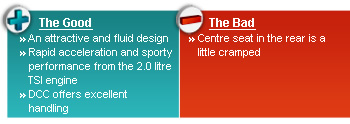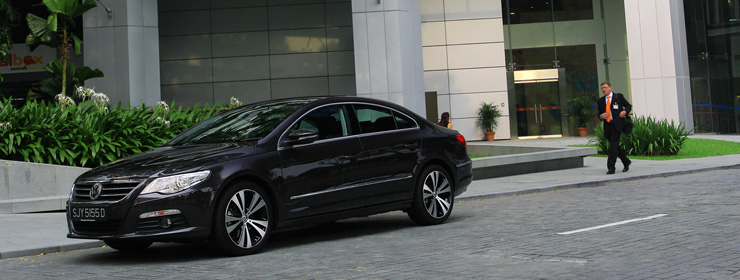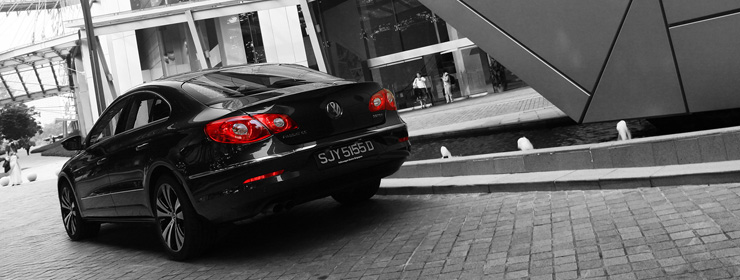Volkswagen Passat CC 2.0 Sport TSI DSG (A) Review
26 Nov 2010|35,657 views
When Mercedes-Benz launched the CLS-Class back in 2004, the world was astounded by its classy elegant shape. Despite the fact that the car was actually based on the W211 E-Class platform it looks nothing like the donor car. What Mercedes-Benz did was to use a proven chassis in its production line-up, sex it up with a new svelte body and market it as a sedan that masquerades as a sexy coupe.
It was only natural that another German manufacturer would take this winning formula and produce a sexy luxury sedan of its own. In this case Volkswagen took their successful Passat platform, threw the sedate body away and plonked on a beautiful swoopy design to give the CLS a run for its money.
Exterior
On first impressions, it looks as if the designer took a sheet of cloth and draped it over the inner workings of the Passat. He then tugged and pulled it taut till he got the desired curves and creases at the right places and used that as his final design. And what a form it is.
From the front, one can see the vague resemblance of the Passat lineage though not much as the CC seems to take on an entirely different design language of its own.
It was only natural that another German manufacturer would take this winning formula and produce a sexy luxury sedan of its own. In this case Volkswagen took their successful Passat platform, threw the sedate body away and plonked on a beautiful swoopy design to give the CLS a run for its money.
Exterior
On first impressions, it looks as if the designer took a sheet of cloth and draped it over the inner workings of the Passat. He then tugged and pulled it taut till he got the desired curves and creases at the right places and used that as his final design. And what a form it is.
From the front, one can see the vague resemblance of the Passat lineage though not much as the CC seems to take on an entirely different design language of its own.
 |
The CC is made up of smooth fluid lines that flow gently and dramatically from the front of the car over the gently raked A-pillars and roof before descending smoothly to converge with the fluid lines in the rear.
Although to fully appreciate the CC's form, one must view it from the flanks to see the genius in the way the designer have led the observer's eye from the front to the rear of the car uninterrupted. The use of frameless doors here also parallels that on the CLS.
The CC sets itself apart from the 'normal' Passat by having a significantly lower roofline at 1,417 mm compared to the 'normal' Passat's 1,472 mm. A slightly wider stance also hints at the sportier underpinnings of this sedan.
 |
On the road, the CC has no equal when it comes to exuding high-style in a luxury sedan except for when it's in the presence of the CLS.
While the 18 inch rims fitted to our test car above is more a 'love it or hate it' affair, customers will receive the generally more palatable "Daytona" design.
Interior
On the inside you find the usual high interior standard of Volkswagen cars but in the CC, you sit slightly lower in the front driver's semi-bucket seats that are similar to those in the Scirocco R. The steeply raked windshield in front further underlines the sportiness of the interior much like a performance coupe.
The driver is faced with a grippy steering that invites you to give it a few quick flicks as you take the large coupe around the bends. Further afield you find the instrument panel that is backlit in white. When you push in the key fob at start-up, the scarlet needles sweep around the clearly defined chrome bezeled dial as if to say 'Achtung!' to the rest of the systems.
Like the dashboard, the centre console is a rather clean and minimalistic affair as the by now familiar audio system takes up the upper half of the console. The RCD 510 system comes with eight speakers spread evenly throughout the interior. Besides the usual radio and CD functions, the capable system also allows you to play tunes from a SD Memory card or your iPod through the AUX-in jack hidden in the centre glove compartment. Of course the usual controls for the audio are replicated on the steering wheel for safe operation while on the road.
While the 18 inch rims fitted to our test car above is more a 'love it or hate it' affair, customers will receive the generally more palatable "Daytona" design.
Interior
On the inside you find the usual high interior standard of Volkswagen cars but in the CC, you sit slightly lower in the front driver's semi-bucket seats that are similar to those in the Scirocco R. The steeply raked windshield in front further underlines the sportiness of the interior much like a performance coupe.
The driver is faced with a grippy steering that invites you to give it a few quick flicks as you take the large coupe around the bends. Further afield you find the instrument panel that is backlit in white. When you push in the key fob at start-up, the scarlet needles sweep around the clearly defined chrome bezeled dial as if to say 'Achtung!' to the rest of the systems.
Like the dashboard, the centre console is a rather clean and minimalistic affair as the by now familiar audio system takes up the upper half of the console. The RCD 510 system comes with eight speakers spread evenly throughout the interior. Besides the usual radio and CD functions, the capable system also allows you to play tunes from a SD Memory card or your iPod through the AUX-in jack hidden in the centre glove compartment. Of course the usual controls for the audio are replicated on the steering wheel for safe operation while on the road.
When the Volkswagen Passat CC was first launched, it was only available in a four seater format like the CLS. Though after much persuasion for practicality by customers, this latest facelifted CC is shipped with a more sensible three seater bench. If for some inexplicable reason you're still bent on the four seater model, you can still place an order with Volkswagen Centre on an indent basis.
While the new bench is now a true three seater with a mini headrest, seatbelts and all, the centre occupant will still find it a bit of a squeeze as the width of the cabin remains the same.
Despite the CC's elaborate styling, it still manages to squeeze in a decently sized trunk. While we don't have any hard figures, we can safely say that it will take at least three golf bags without problems. Nevertheless this large trunk is supplemented with the split folding rear bench.
The Drive
The Passat CC tested here is powered by the ubiquitous 2.0-litre TSI engine found in a number of Volkswagen models. Most notably the Golf GTI. The biggest difference between the latest CC and the old is the addition of a new six-speed DSG box compared to the old Tiptronic tranny.
Besides the obvious positives in quicker shifting, the new box also lifts the fuel economy by nearly 1km/L to 12.7km/L as opposed to the older car's 12km/L.
Matting the throttle, the 200bhp sedan gets up to speed quickly and without drama while the TSI powerplant verbalises its displeasure through muted snarls in the higher revs.
While the new bench is now a true three seater with a mini headrest, seatbelts and all, the centre occupant will still find it a bit of a squeeze as the width of the cabin remains the same.
Despite the CC's elaborate styling, it still manages to squeeze in a decently sized trunk. While we don't have any hard figures, we can safely say that it will take at least three golf bags without problems. Nevertheless this large trunk is supplemented with the split folding rear bench.
The Drive
The Passat CC tested here is powered by the ubiquitous 2.0-litre TSI engine found in a number of Volkswagen models. Most notably the Golf GTI. The biggest difference between the latest CC and the old is the addition of a new six-speed DSG box compared to the old Tiptronic tranny.
Besides the obvious positives in quicker shifting, the new box also lifts the fuel economy by nearly 1km/L to 12.7km/L as opposed to the older car's 12km/L.
Matting the throttle, the 200bhp sedan gets up to speed quickly and without drama while the TSI powerplant verbalises its displeasure through muted snarls in the higher revs.
 |
While the CC might be a rather long and low sedan, it handles very much unlike its dimensions. Granted the CC is no GTI but the litheness experienced in the corners gives the impression that the CC has much better body control than in the Passat. This is in no doubt helped by the Dynamic Chassis Control system that was first introduced in the current generation Golf GTI.
In 'Sport' mode, the large CC feels rather lithe through the bends as it doesn't sway or carom in the corners like a large sedan should.
In 'Sport' mode, the large CC feels rather lithe through the bends as it doesn't sway or carom in the corners like a large sedan should.
Conclusion
The Passat CC is offered in three different variants. An entry-level 1.8-litre sharing the same powerplant as in the Passat, a mid-range 2.0-litre Sport (tested here) and a range topping 3.6-litre 300bhp model.
Considering the negligible price difference of $4,000 between the similarly engined Passat and Passat CC, I would be hard pressed to think of why anyone would even consider the less attractive sibling. Drivers who prefer a livelier drive should head straight for the 2.0-litre model tested here for some weekend motoring nirvana.
What do you think? Jot down your opinions at the comment box below.
The Passat CC is offered in three different variants. An entry-level 1.8-litre sharing the same powerplant as in the Passat, a mid-range 2.0-litre Sport (tested here) and a range topping 3.6-litre 300bhp model.
Considering the negligible price difference of $4,000 between the similarly engined Passat and Passat CC, I would be hard pressed to think of why anyone would even consider the less attractive sibling. Drivers who prefer a livelier drive should head straight for the 2.0-litre model tested here for some weekend motoring nirvana.
What do you think? Jot down your opinions at the comment box below.
When Mercedes-Benz launched the CLS-Class back in 2004, the world was astounded by its classy elegant shape. Despite the fact that the car was actually based on the W211 E-Class platform it looks nothing like the donor car. What Mercedes-Benz did was to use a proven chassis in its production line-up, sex it up with a new svelte body and market it as a sedan that masquerades as a sexy coupe.
It was only natural that another German manufacturer would take this winning formula and produce a sexy luxury sedan of its own. In this case Volkswagen took their successful Passat platform, threw the sedate body away and plonked on a beautiful swoopy design to give the CLS a run for its money.
Exterior
On first impressions, it looks as if the designer took a sheet of cloth and draped it over the inner workings of the Passat. He then tugged and pulled it taut till he got the desired curves and creases at the right places and used that as his final design. And what a form it is.
From the front, one can see the vague resemblance of the Passat lineage though not much as the CC seems to take on an entirely different design language of its own.
It was only natural that another German manufacturer would take this winning formula and produce a sexy luxury sedan of its own. In this case Volkswagen took their successful Passat platform, threw the sedate body away and plonked on a beautiful swoopy design to give the CLS a run for its money.
Exterior
On first impressions, it looks as if the designer took a sheet of cloth and draped it over the inner workings of the Passat. He then tugged and pulled it taut till he got the desired curves and creases at the right places and used that as his final design. And what a form it is.
From the front, one can see the vague resemblance of the Passat lineage though not much as the CC seems to take on an entirely different design language of its own.
 |
The CC is made up of smooth fluid lines that flow gently and dramatically from the front of the car over the gently raked A-pillars and roof before descending smoothly to converge with the fluid lines in the rear.
Although to fully appreciate the CC's form, one must view it from the flanks to see the genius in the way the designer have led the observer's eye from the front to the rear of the car uninterrupted. The use of frameless doors here also parallels that on the CLS.
The CC sets itself apart from the 'normal' Passat by having a significantly lower roofline at 1,417 mm compared to the 'normal' Passat's 1,472 mm. A slightly wider stance also hints at the sportier underpinnings of this sedan.
 |
On the road, the CC has no equal when it comes to exuding high-style in a luxury sedan except for when it's in the presence of the CLS.
While the 18 inch rims fitted to our test car above is more a 'love it or hate it' affair, customers will receive the generally more palatable "Daytona" design.
Interior
On the inside you find the usual high interior standard of Volkswagen cars but in the CC, you sit slightly lower in the front driver's semi-bucket seats that are similar to those in the Scirocco R. The steeply raked windshield in front further underlines the sportiness of the interior much like a performance coupe.
The driver is faced with a grippy steering that invites you to give it a few quick flicks as you take the large coupe around the bends. Further afield you find the instrument panel that is backlit in white. When you push in the key fob at start-up, the scarlet needles sweep around the clearly defined chrome bezeled dial as if to say 'Achtung!' to the rest of the systems.
Like the dashboard, the centre console is a rather clean and minimalistic affair as the by now familiar audio system takes up the upper half of the console. The RCD 510 system comes with eight speakers spread evenly throughout the interior. Besides the usual radio and CD functions, the capable system also allows you to play tunes from a SD Memory card or your iPod through the AUX-in jack hidden in the centre glove compartment. Of course the usual controls for the audio are replicated on the steering wheel for safe operation while on the road.
While the 18 inch rims fitted to our test car above is more a 'love it or hate it' affair, customers will receive the generally more palatable "Daytona" design.
Interior
On the inside you find the usual high interior standard of Volkswagen cars but in the CC, you sit slightly lower in the front driver's semi-bucket seats that are similar to those in the Scirocco R. The steeply raked windshield in front further underlines the sportiness of the interior much like a performance coupe.
The driver is faced with a grippy steering that invites you to give it a few quick flicks as you take the large coupe around the bends. Further afield you find the instrument panel that is backlit in white. When you push in the key fob at start-up, the scarlet needles sweep around the clearly defined chrome bezeled dial as if to say 'Achtung!' to the rest of the systems.
Like the dashboard, the centre console is a rather clean and minimalistic affair as the by now familiar audio system takes up the upper half of the console. The RCD 510 system comes with eight speakers spread evenly throughout the interior. Besides the usual radio and CD functions, the capable system also allows you to play tunes from a SD Memory card or your iPod through the AUX-in jack hidden in the centre glove compartment. Of course the usual controls for the audio are replicated on the steering wheel for safe operation while on the road.
When the Volkswagen Passat CC was first launched, it was only available in a four seater format like the CLS. Though after much persuasion for practicality by customers, this latest facelifted CC is shipped with a more sensible three seater bench. If for some inexplicable reason you're still bent on the four seater model, you can still place an order with Volkswagen Centre on an indent basis.
While the new bench is now a true three seater with a mini headrest, seatbelts and all, the centre occupant will still find it a bit of a squeeze as the width of the cabin remains the same.
Despite the CC's elaborate styling, it still manages to squeeze in a decently sized trunk. While we don't have any hard figures, we can safely say that it will take at least three golf bags without problems. Nevertheless this large trunk is supplemented with the split folding rear bench.
The Drive
The Passat CC tested here is powered by the ubiquitous 2.0-litre TSI engine found in a number of Volkswagen models. Most notably the Golf GTI. The biggest difference between the latest CC and the old is the addition of a new six-speed DSG box compared to the old Tiptronic tranny.
Besides the obvious positives in quicker shifting, the new box also lifts the fuel economy by nearly 1km/L to 12.7km/L as opposed to the older car's 12km/L.
Matting the throttle, the 200bhp sedan gets up to speed quickly and without drama while the TSI powerplant verbalises its displeasure through muted snarls in the higher revs.
While the new bench is now a true three seater with a mini headrest, seatbelts and all, the centre occupant will still find it a bit of a squeeze as the width of the cabin remains the same.
Despite the CC's elaborate styling, it still manages to squeeze in a decently sized trunk. While we don't have any hard figures, we can safely say that it will take at least three golf bags without problems. Nevertheless this large trunk is supplemented with the split folding rear bench.
The Drive
The Passat CC tested here is powered by the ubiquitous 2.0-litre TSI engine found in a number of Volkswagen models. Most notably the Golf GTI. The biggest difference between the latest CC and the old is the addition of a new six-speed DSG box compared to the old Tiptronic tranny.
Besides the obvious positives in quicker shifting, the new box also lifts the fuel economy by nearly 1km/L to 12.7km/L as opposed to the older car's 12km/L.
Matting the throttle, the 200bhp sedan gets up to speed quickly and without drama while the TSI powerplant verbalises its displeasure through muted snarls in the higher revs.
 |
While the CC might be a rather long and low sedan, it handles very much unlike its dimensions. Granted the CC is no GTI but the litheness experienced in the corners gives the impression that the CC has much better body control than in the Passat. This is in no doubt helped by the Dynamic Chassis Control system that was first introduced in the current generation Golf GTI.
In 'Sport' mode, the large CC feels rather lithe through the bends as it doesn't sway or carom in the corners like a large sedan should.
In 'Sport' mode, the large CC feels rather lithe through the bends as it doesn't sway or carom in the corners like a large sedan should.
Conclusion
The Passat CC is offered in three different variants. An entry-level 1.8-litre sharing the same powerplant as in the Passat, a mid-range 2.0-litre Sport (tested here) and a range topping 3.6-litre 300bhp model.
Considering the negligible price difference of $4,000 between the similarly engined Passat and Passat CC, I would be hard pressed to think of why anyone would even consider the less attractive sibling. Drivers who prefer a livelier drive should head straight for the 2.0-litre model tested here for some weekend motoring nirvana.
What do you think? Jot down your opinions at the comment box below.
The Passat CC is offered in three different variants. An entry-level 1.8-litre sharing the same powerplant as in the Passat, a mid-range 2.0-litre Sport (tested here) and a range topping 3.6-litre 300bhp model.
Considering the negligible price difference of $4,000 between the similarly engined Passat and Passat CC, I would be hard pressed to think of why anyone would even consider the less attractive sibling. Drivers who prefer a livelier drive should head straight for the 2.0-litre model tested here for some weekend motoring nirvana.
What do you think? Jot down your opinions at the comment box below.
Car Information
Volkswagen Passat CC 2.0 Sport TSI DSG (A)
CAT B|Petrol|12.7km/L
Horsepower
149kW (200 bhp)
Torque
280 Nm
Acceleration
7.7sec (0-100km /hr)
This model is no longer being sold by local distributor
All Used Volkswagen Passat CCThank You For Your Subscription.
















































